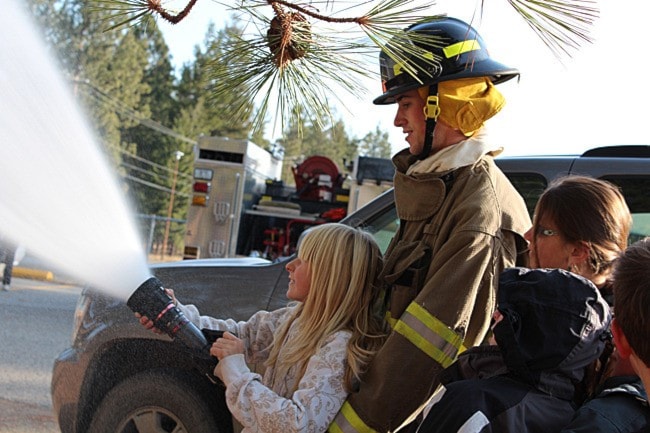Every day in B.C. emergency crews are called out to respond to crash sites, fires and other emergency situations that are often life threatening to both the victims and the first responders. For fire departments, one of the first lines of defence necessary to avoid tragedy is education. Every year, fire departments all across Canada visit schools to speak about fire safety.
Last Tuesday and Thursday, the Princeton Fire Department visited both John Allison Elementary and Vermilion Forks School to talk what if. The students were shown a DVD. Then, they were taken outside to spray water from the high pressure fire hose. The kids all toured the truck and “listened intently to us while we spoke with them,” said fire crew member Donald Miller.
Dawn Gardner, another fire department volunteer, said, “we have been doing this for many years. It’s an annual thing that we try to do close to Fire Prevention Week. We talk about 911, Stop, Drop and Roll and about the way the fire rescue workers look when they are all geared up. We don’t want the kids to back away and hide from the rescue workers.
Gardner and Brian Burnstad went into the classroom and walked the students through each piece of protective gear right down to their oxygen tanks and radios. They informed the classes about their life saving buddy system. Kitchen safety and smoke detectors, escape routes and fire prevention were all part of the presentations. “We want people to get out alive,” stated Gardner “and part of that starts with everyone in their homes. Do they have an escape route, a meeting place and working smoke detectors?”
When fully dressed, each fire fighter has around 50 pounds of gear on. “Charged (pressurized) hoses, axes and all our other tools are extra,” added Burnstad. The kids were invited to try and lift up the oxygen tanks and see just how heavy they are. They got to feel the gloves and helmet and get up close and personal with the fire gear that keeps the fire fighters safe from the heat. Gardner told the students that even then the equipment alone is not enough. “We have a melted helmet back at the station that one of our members wore during a fire. The heat is so intense it is incredible. That is why it is so important for us to work together on a buddy system when we are fighting fire. Our partner is our life line. They listen for alarms that tell us our oxygen is low or that there is some sort of problem. We need to know where our partner is at all times.”
“We want every child to know how to phone 911 and what their address is so they can tell the fire department. We want the kids to know not to hide from the fire fighters even though they look kind of weird all dressed up and we want kids to know to go out the nearest fire exit.”
The message was clear. Prevention is the most important piece of fire safety, but fire fighters know that in spite of the best efforts, fires do happen. “When they do we want people to be prepared. They need to have a plan,” Gardner concluded.
